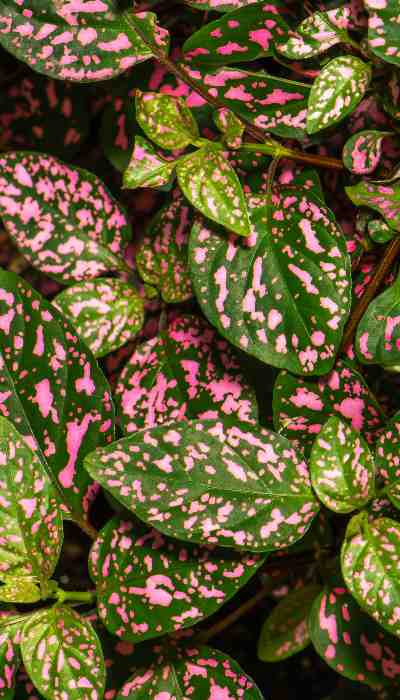While there are plenty of varieties available, the most popular variety of polka dot plants is the variegated polka dot plant (Hypoestes Phyllostachys).
The best part about these plants? They’re super easy to care for! Even if you don’t have much growing experience, you can keep your polka dot plant thriving by following these simple care tips. Let’s start with how to grow your polka dot plant from seed or cutting…

What is the Polka Dot Plant?
The polka dot plant, or Plectranthus coleoids, is a perennial succulent that thrives in low light conditions. It has small, dark green leaves arranged around the stem with clusters of small white flowers. This plant is very popular in homes because it can thrive without direct sunlight. The plants are native to South Africa and are typically propagated by cuttings or division.
To propagate by cutting, take a 3-4 inch long cutting from the parent plant’s main stem below an offset node. Dip in the rooting hormone and then place it in moist potting soil. To divide your existing plant you need to select a clump of several offset nodes (at least 8) with healthy roots that have plenty of room to grow between them.
Use sharp shears to cut down through all the roots at once, then gently tug on each piece until they separate enough so they will not be connected again when you finish dividing them. Plant each new clump into its own container filled with potting soil.
Getting Started with This Curious Cactus

This plant is a cactus-hybrid, a cross between a polka dot plant and another type of cactus. So how do you care for this strange-looking houseplant? Here are some tips on how to take care of your polka dot plant:
Location: This plant thrives in bright, indirect light, but be careful not to put it in direct sunlight. Keep it close enough that it can soak up the light, but not directly under an overhead light or lamp.
Watering: The soil should feel dry before you water the plant again. Use lukewarm water and let the excess water drain out of the saucer that collects rainwater below the pot.
Fertilizer: Give your polka dot plant fertilizer during its growing season, typically March through October. If you’re using a granular fertilizer, sprinkle about one tablespoon around the base of the plant.
If you’re using liquid fertilizer, pour it into a saucer and soak both sides of the leaves once every two weeks with one teaspoon each time. After fertilizing, rinse off any extra liquid from the leaves so they don’t get too wet.
So there you have it! With these helpful tips, caring for your polka dot plant should be no problem at all. You’ll have plenty of beautiful blooms to admire in no time!
Where to Get a Polka Dot Plant?
This trendy house plant can be found at most garden centers. If you don’t have a local nursery near you, you can find them online or order one of the many varieties available on Amazon.
When it comes to planting, polka dot plants are versatile. They can grow in containers, hanging baskets, or even upside down if you’re looking for something unique.
The polka dot plant is a very low-maintenance plant, which means that all it needs is a little water every couple of weeks! Just make sure not to overwater; the soil should be dry before watering again.
The polka dot plant also does well when exposed to natural light and prefers temperatures between 50-80 degrees Fahrenheit. While these plants can tolerate some cold weather, they will suffer frost damage below 40 degrees Fahrenheit. You may need to bring your plant inside during the winter months.
This fun foliage is perfect for adding color to any space. It’s also an excellent option for anyone who has difficulty keeping houseplants alive because of its hardiness!
Growing Your Own Polka Dot Plant
Polka dot plant, also known as Hypoestes, is a relatively easy houseplant that you can grow from seed. The best time to sow the seeds is during the spring or fall. To start a polka dot plant from seed, first, soak it overnight in water. Next, place the seeds on top of moist soil and keep them in a warm environment until they sprout.
Once they do, place them in a pot filled with soil (a mixture of peat moss and sand works well) with some drainage holes near the bottom. Water regularly so that the soil stays moist but not wet. You will know when your polka dot plant needs more water because it will droop its leaves if it’s thirsty!
Getting Rid of Mealybugs on Your Polka Dot Plant
Mealybugs are the most common insect found on polka dot plants. These pesky critters can cause serious damage to your plant if not treated right away. The best way to get rid of mealybugs is by using a cotton swab dipped in rubbing alcohol.
Simply apply the alcohol directly onto the mealybug as it will seep into their waxy exoskeleton. Once they’re doused with alcohol, they should come off easily. Repeat this process until all bugs have been removed from the plant.
The next time you notice any signs of an infestation, try adding some cinnamon oil or tea tree oil to the potting soil. These essential oils are great at repelling insects and preventing them from coming back again.
If you want your plant to live up to its name and look like true polka dots, consider planting white or pink flowers around it!
Choosing Succulents Over Others
When it comes to houseplants, succulents are the trendiest. They come in a wide variety of shapes, sizes, and colors, so you can find a perfect match for your décor. Plus, they require less maintenance than other types of plants. While some succulents can be tricky to care for – keeping them watered is key – there are varieties that will thrive with minimal upkeep.
The polka dot plant (Hypoestes Phyllostachys) is one such type of succulent. It’s not picky about light or soil as long as it gets moist every few days. And when watering, don’t give too much water at once. Too much water will cause root rot, which kills the plant. Soak the potting soil until it feels just wet but not soggy. After a week or two, poke your finger into the potting soil to see if it needs more water again. If it feels dry then go ahead and add some more water.
Maintaining Your New Pet

- Place the plant in a sunlit window with a temperature of between 65-90 degrees Fahrenheit.
- Ensure that the soil is moist, but not wet.
- Fertilize your polka dot plant once every two weeks with a general-purpose fertilizer.
- Water your plant when the soil starts feeling dry at about an inch deep.
- Change the potting soil every year or so, as it can start drying out and clogging up the drainage holes.
- Transplant your polka dot plant into a bigger pot when it begins to get root bound.
- Prune off any dead or dying leaves or stems that have become too long or leggy.
- Report the polka dot plant if necessary.
- Keep insects away from your pet by occasionally spraying with insecticidal soap or making sure plants are well-ventilated.
- Be careful with children and pets around the polka dot plant, especially those with sensitive skin who may react poorly to coming in contact with the sap.
- Make sure there is always water sitting in the tray under the pot so that no roots are left without moisture.
- Watch your new pet carefully for signs of overwatering, pest infestation, or other problems.
- Enjoy watching your new little friend grow!
Conclusion
The polka dot plant is a trendy houseplant that will make any office, living room or kitchen feel fresh. It’s easy enough to grow but does require a little TLC. Our tips will help you keep your polka dot plant happy, healthy, and beautiful.
Also, check out the latest articles “Purple passion plant” and “Manjula pothos“
Hi I’m Bilal Malik, a digital marketing and blogging expert holding years of experience.










